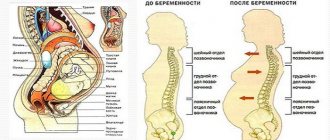Post-infarction cardiosclerosis
Post-infarction cardiosclerosis is a disease characterized by partial replacement of the heart muscle with connective tissue. A similar pathological process, leading to dysfunction of the affected segment, is a consequence of another dangerous disease - myocardial infarction.
- Etiology
- Classification
- Symptoms
- Diagnostics
- Treatment
- Possible complications
- Prevention and prognosis
There are several predisposing factors that influence the development of pathology, but the main one is changes in the body from a myocardial infarction.
The basis of the clinical picture is the signs of heart failure, which is why it is impossible to make a correct diagnosis based only on symptoms. Symptoms include irregular heart rate, shortness of breath, swelling and increased fatigue.
Diagnostics includes a wide range of instrumental procedures, but last but not least is the history and physical examination performed by a cardiologist.
Treatment of post-infarction cardiosclerosis depends on the severity of its course, which is why tactics can be medicinal or surgical.
The International Classification of Diseases, Tenth Revision, allocates its own code for such a disease. ICD-10 code – I 25.2.
Diagnostic measures
It is quite difficult to diagnose cardiosclerosis in the early stages, since the results of blood tests will not be informative, and other methods will not be able to show the degree of development of connective tissue in the myocardium at this stage. And patients rarely come specifically for a comprehensive examination for cardiosclerosis, since there are practically no symptoms.
It is the late seeking of help, which occurs already in the presence of symptoms of heart failure, that makes the treatment of the pathology quite problematic and lengthy. And in some cases, life forecasts are very disappointing.
Planned diagnostic measures are carried out only for patients who have previously suffered a heart attack, myocarditis, or are registered at a dispensary for acute coronary heart disease. A whole range of studies is carried out to make a diagnosis of “post-infarction cardiosclerosis”:
- collecting an anamnesis allows the specialist to draw up a general picture of the patient’s condition, listen to his complaints and draw up a plan for further examination;
- laboratory tests of blood and urine. The analysis is not particularly informative, since this pathology does not cause sudden changes in indicators. However, with myocarditis, a blood test can determine the presence of an inflammatory process, and with atherosclerosis, an increase in cholesterol levels;
- X-rays give only a general idea of the condition of the heart and are useful in making a preliminary diagnosis. In addition, in the later stages of pathology development, it is possible to estimate the size of the organ enlargement;
- on the ECG you can see characteristic changes in the work of the heart;
- Echocardiography is one of the most accurate and informative diagnostic methods. Using this study, information can be obtained about the functional capacity and structure of the organ;
- CT and MRI have approximately the same information content. Using these studies, it is possible to determine areas of connective tissue in the heart, their location and size;
- Scintigraphy makes it possible, using contrast, to identify areas of the heart damaged by atherosclerosis.
Based on the results of all studies, the cardiologist can create a treatment plan for the patient to eliminate the cause, minimize uncomfortable symptoms and significantly improve the quality of life.
Today, there are no effective methods for treating post-infarction cardiosclerosis that would permanently relieve the patient of the problem. Science knows of no drugs that could transform connective tissue back into full-fledged cardiomyocytes - functional cells of the heart muscle.
Causes of the disease
Experts in the field of cardiology consider post-infarction cardiosclerosis as an independent type of coronary heart disease. The changes inherent in such a disease, namely the replacement of dead myocardial fibers with connective tissue, are diagnosed in patients approximately 4 months after the underlying disease. This interval is due to the fact that it is during this time that a process such as myocardial scarring is completed.
The history of the disease of post-infarction cardiosclerosis is based on the fact that after a person has survived the main illness, the formation of necrosis of the heart muscle occurs, and its restoration, in turn, occurs due to the fact that the process of proliferation of scar-connective tissue occurs.
Areas of scarring have different volumes and areas of formation, which affect the nature and level of cardiac dysfunction. The resulting tissue does not have the ability to contractile function. Such factors cause a decrease in ejection fraction, changes in heart rate and conduction disturbances occurring inside the heart.
The disease is complemented by the following changes:
- dilatation of the heart chambers;
- cardiac muscle hypertrophy;
- heart failure.
It is worth noting that in addition to the main cause, provocateurs of post-infarction cardiosclerosis are:
- myocardial dystrophy;
- diffuse cardiosclerosis;
- inflammatory damage to the myocardium;
- a wide range of cardiac injuries.
Nevertheless, the above sources serve as provocateurs much less often.
The following factors can complicate the course of the disease:
- addiction to bad habits;
- poor nutrition;
- presence of excess body weight;
- lack of moderate physical activity, which is recommended for patients after myocardial infarction or other types of coronary heart disease;
- the influence of stressful situations and nervous tension;
- patient refusal of adequate preventive therapy.
The above reasons often lead to death or to the fact that the patient requires constant care, that is, the implementation of the nursing process.
Development mechanism
The reasons that we listed above lead to a lack of oxygen in the tissues of the heart. Gradually, normal muscles are replaced by connective tissue, which is not capable of bearing a functional load. Thus, the work of the heart begins to be performed by neighboring normal tissue areas.
As a result of this process, normal areas that perform double work are hypertrophied, that is, they increase in size due to vigorous activity. However, the heart cannot withstand such heavy loads, so the “tired” muscles are again replaced by connective tissue. This tissue stretches, the myocardial cavities expand, disrupting blood circulation. All this leads to heart failure.
Classification of the disease
In modern medicine, several varieties of this disease are considered:
- focal - replacement with connective tissue is observed only in some areas of the myocardium;
- diffuse - the heart muscle is completely replaced by tissue. The scar lesion spreads evenly and everywhere;
- involving the valve apparatus in the pathology is the rarest type of the disease.
The focal form of the disease has its own division, which is why it is distinguished:
- diffuse or small-focal post-infarction cardiosclerosis - during diagnosis it is expressed in small streaks, stripes or areas with a whitish tint. This often develops against the background of atrophy or degeneration of heart tissue;
- large-focal post-infarction cardiosclerosis - differs in that it has an unfavorable prognosis - this is explained by the complexity of treatment. An aneurysm often forms in the affected area, which is why its location is of no small importance.
The severity of the pathology and the severity of symptoms depend on several factors that cardiologists pay attention to during diagnosis. Thus, the disease can also be divided according to the following criteria:
- the depth of the necrotic lesion is superficial or transmural. In the second case, necrosis spreads to all layers of the muscle wall;
- localization of the focus of necrosis - the walls of the atria, interventricular septa, walls of the left or right ventricle. Damage to the left ventricle is considered the most dangerous;
- the total number of foci formed – single (often large) and multiple (most often small).
Elimination of cardiosclerosis using stem cells
Today, research is actively underway on the use of stem cells in the treatment of cardiosclerosis. It is believed that this technique can not only ease the symptoms, but also restore the structure of the parts of the heart affected by scars.
How is this treatment carried out? First, doctors collect viable stem cells from the patient's tissue. Next, the collected material is cultivated in laboratory conditions, which allows the number of cells to be increased. This process lasts 1-2 months.
After this period, the patient is prescribed two operations to implant stem cells. During the procedure, these structures are attached to healthy areas of the myocardium. It's no secret that stem cells can turn into any type of cell - in this case, cardiomyocytes. Thus, over the course of a year, new, healthy muscle structures are formed, which replace connective tissue elements.
Symptoms of the disease
The intensity of the manifestation of clinical signs is dictated by the prevalence of the pathological process in the heart muscle - the larger it is, the brighter the symptoms will be.
The basis of the symptoms are manifestations characteristic of heart failure. It follows from this that post-infarction cardiosclerosis is characterized by the following symptomatic picture:
- severe shortness of breath that occurs with moderate physical activity or at rest;
- a sharp increase in heart rate, to such an extent that a person feels his own heartbeat;
- cyanosis of the lips, fingertips on the upper and lower extremities, as well as in the area surrounding the nose;
- cold extremity syndrome;
- arrhythmias of various types - such a symptom is detected on the ECG;
- ascites and other conditions caused by the accumulation of large amounts of fluid in the body, for example, hydrothorax or hydropericardium;
- increased fatigue;
- violation of the breathing process in a horizontal position of the body;
- development of cardiac asthma attacks at night. About twenty minutes after a person changes his body position - from horizontal to vertical or sitting, breathing returns to normal. If this is not done, arterial hypertension will occur, which can cause pulmonary edema. This condition is also called acute left ventricular failure;
- swelling of the legs - this symptom appears due to involvement of the right ventricle in the pathology. Swelling of the hands and the entire body is extremely rare;
- swelling of the veins in the neck;
- an increase in liver volume, which can be detected by a person independently by palpation of the right hypochondrium;
- pain of varying severity behind the sternum or in the heart area;
- periods of sudden angina pectoris, developing due to coronary circulation disorders.
Post-infarction cardiosclerosis
Atherosclerotic
The walls of the heart vessels are susceptible to attack by atherosclerotic plaques. They disrupt blood circulation, supply the brain and heart with the required amount of oxygen and substances important for the body.
Due to the large accumulation of cholesterol, more stress is placed on the heart to push blood through. This is why the left ventricle enlarges and cardiac tissue starves. This is where atherosclerotic cardiosclerosis of the heart appears.
Over time, the affected parts are replaced by connective tissue, which outwardly looks like rough scars that do not allow the heart to contract normally. Examining the patient, doctors note an enlargement of the heart and its displacement to the left.
Symptoms:
- cardiac asthma;
- failure in the left ventricle, characteristic wheezing in the pulmonary lobes;
- dyspnea;
- peripheral edema;
- atrial fibrillation.
Insufficiency in the right ventricle is gradually added. This cardiosclerosis is characterized by stable hypertension, dysfunction of the brain and other organs, since starvation is also observed here.
Cardiac asthma is one of the signs of atherosclerotic cardiosclerosis
The methods used for diagnosis are identical to the previous types: MRI, ultrasound, ECG. Thanks to them, doctors are able to identify the extent of damage to the heart muscle and predict further consequences.
Diagnostics
The diagnosis of post-infarction cardiosclerosis can only be made by a cardiologist, based on studying the results of instrumental examinations. However, the first stage of diagnostic measures includes the work of the clinician with the patient, namely:
- familiarization with the medical history;
- collection and analysis of the patient’s life history - to identify factors that significantly increase the likelihood of developing complications of the disease;
- a thorough physical examination - must include listening to the patient using a phonendoscope to determine heart rate, palpation of the area under the right ribs and studying the condition of the skin;
- a detailed survey - to determine the severity of clinical signs, which will indicate the level of severity of the disease.
Instrumental diagnostics involves the following:
- radiography of the sternum;
- Ultrasound of the heart;
- ECG and EchoCG;
- rhythmocardiography;
- coronary angiography;
- stress tests such as bicycle ergometry and treadmill tests;
- 24-hour ECG monitor;
- PAT;
- ventriculography.
Laboratory tests are not involved in diagnosing such a disease, since they do not show any deviations or minor changes.
Treatment of the disease
Post-infarction cardiosclerosis can be eliminated using both conservative and surgical techniques.
The goals of inoperable treatment are:
- slowing down the progression of heart failure;
- prevention of disturbances in cardiac conduction and heart rhythm;
- preventing the spread of pathological tissue to healthy areas.
Therapy for such a pathology should consist of:
- complete elimination of nervous tension;
- maintaining a gentle diet;
- restrictions on physical activity;
- taking medications prescribed by the attending physician, taking into account all contraindications.
Treatment of post-infarction cardiosclerosis with medications is aimed at using:
- ACE inhibitors;
- beta blockers;
- nitrates;
- disaggregants;
- diuretics;
- metabolites, fibrates and statins.
Drugs for post-infarction cardiosclerosis
The diet involves giving up:
- strong coffee, cocoa and black tea;
- salt - its consumption should be minimal, namely no more than three grams per day;
- fatty types of meat and fish;
- onions and garlic, radishes and radishes;
- all varieties of cabbage;
- offal and smoked meats;
- fried and spicy foods;
- legumes;
- ingredients containing stabilizers, dyes, emulsifiers and other food additives.
Medical intervention is carried out using the following methods:
- implantation of a pacemaker or cardioverter-defibrillator;
- coronary artery bypass grafting;
- angioplasty;
- resection of the aneurysm.
When is surgery necessary?
Unfortunately, not in all cases it is possible to eliminate the manifestations of the disease called “cardiosclerosis” using conservative methods. Treatment can also be surgical. For example, in case of severe heart rhythm disturbances, implantation of an electrical pacemaker is indicated.
If there are disturbances in the functioning of the coronary arteries, the doctor may recommend that the patient undergo stenting of the coronary vessels or angioplasty. If the disease is exacerbated by the development of an aortic aneurysm, then its removal with further coronary artery bypass surgery is indicated.
Possible complications
Delayed or incorrect therapy almost always leads to the development of complications, which include:
- atrial fibrillation;
- the formation of diverse blockades;
- left ventricular aortic aneurysms;
- thrombosis and thromboembolism;
- ventricular extrasystole;
- paroxysmal ventricular tachycardia;
- complete atrioventricular block;
- weakness of the sinus node;
- tamponade of the pericardial cavity;
- aneurysm rupture;
- asystole.
Such consequences are fraught with either death or a significant deterioration in the patient’s condition, up to the need for a nursing process, which includes:
- replacement of bed linen and underwear of the patient;
- ventilation of the room;
- treating the room in which the patient is located with ultraviolet rays;
- conducting conversations with the patient and his relatives about caring for health and the importance of taking medications;
- control over daily routine and nutrition;
- assistance in finding motivation to change lifestyle.
Prevention and prognosis
The occurrence of the disease can be prevented through early detection, timely and adequate elimination of myocardial infarction. To prevent the formation of the underlying disease it is necessary:
- completely give up addictions;
- lead a moderately active lifestyle;
- eat properly and nutritiously;
- avoid physical and emotional stress;
- normalize body weight;
- prevent heart injuries;
- Visit a cardiologist several times a year for preventive examinations.
The outcome of post-infarction cardiosclerosis is often disappointing - it depends on the location of the foci of myocardial tissue replacement and the severity of the disease. Pathological changes, in particular arrhythmia and heart failure, are irreversible, and their treatment leads to temporary improvements. Quite often complications develop that lead to the death of a person.
If you think you have post-infarction cardiosclerosis
and symptoms characteristic of this disease, then a cardiologist can help you.
Source Did you like the article? Share with friends on social networks:











